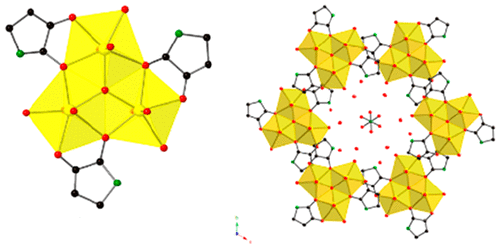当前位置:
X-MOL 学术
›
Inorg. Chem.
›
论文详情
Our official English website, www.x-mol.net, welcomes your
feedback! (Note: you will need to create a separate account there.)
3-Hydroxy-2-Pyrrolidinone as a Potential Bidentate Ligand for in Vivo Chelation of Uranyl with Low Cytotoxicity and Moderate Decorporation Efficacy: A Solution Thermodynamics, Structural Chemistry, and in Vivo Uranyl Removal Survey
Inorganic Chemistry ( IF 4.3 ) Pub Date : 2019-02-08 00:00:00 , DOI: 10.1021/acs.inorgchem.8b03442 Xiaomei Wang 1, 2, 3 , Suqiang Wu 4 , Jingwen Guan 3 , Lanhua Chen 3 , Cen Shi 3 , Jianmei Wan 3 , Yong Liu 4 , Juan Diwu 3 , Jianqiang Wang 1, 2 , Shuao Wang 3
Inorganic Chemistry ( IF 4.3 ) Pub Date : 2019-02-08 00:00:00 , DOI: 10.1021/acs.inorgchem.8b03442 Xiaomei Wang 1, 2, 3 , Suqiang Wu 4 , Jingwen Guan 3 , Lanhua Chen 3 , Cen Shi 3 , Jianmei Wan 3 , Yong Liu 4 , Juan Diwu 3 , Jianqiang Wang 1, 2 , Shuao Wang 3
Affiliation

|
Uranium poses a threat for severe renal and bone damage in vivo. With the rapid development of nuclear industry, it is more urgent than ever to search for potential in vivo uranium chelators. In this work, 3-hydroxy-2-pyrrolidinone (HPD) is investigated as a new potential uranium decorporation ligand. The potentiometric titration measurements were carried out, and the stability constants were determined to be log β110 = 10.5(7), log β120 = 20.7(9), and log β130 = 28.2(4). The species distribution diagram shows that nearly all uranyl is complexed by HPD at pH 7.4 under the defined condition. A single crystal of uranyl and HPD complexes, [(UO2)3O(H2O)3(C4H6NO2)3]·NO3·12H2O (uranyl-HPD), was obtained via an evaporation method. The overall structure of uranyl-HPD is a trimer that consists of three uranyl units and three HPD ligands. The uranyl unit is equatorially coordinated by three oxygen atoms from two HPD agents, one coordinated water molecule, and one μ3-O atom that is shared by three uranyl units. The results of the cytotoxicity assay indicate that the ligand is less toxic than the chelators used clinically (i.e., DTPA-ZnNa3 and 3-hydroxy-1,2-dimethyl-4(1H)-pyridone (DFP)). The results of the uranium removal assay using the NRK-52E cell show that it could reduce as much as 58% of the uranium content at the cellular level. Furthermore, the in vivo uranium decorporation assays demonstrate that HPD can remove 52% of uranium deposited in the kidney but shows poor uranium removal efficacy in the bone.
中文翻译:

3-Hydroxy-2-Pyrrolidinone作为潜在的双齿配体,用于尿嘧啶的体内螯合,具有低细胞毒性和中等的脱附功效:溶液热力学,结构化学和体内铀去除率调查
铀在体内会严重损害肾脏和骨骼。随着核工业的快速发展,寻找潜在的体内铀螯合剂比以往任何时候都更加紧迫。在这项工作中,研究了3-羟基-2-吡咯烷酮(HPD)作为一种新的潜在的铀分解配体。电位滴定测定进行,并测定稳定常数为β日志110 = 10.5(7),日志β 120 = 20.7(9),并登录β 130 = 28.2(4)。种类分布图显示,在规定的条件下,几乎所有的铀酰都被pH 7.4的HPD络合。铀酰和HPD配合物的单晶,[(UO 2)3 O(H通过蒸发法获得2 O)3(C 4 H 6 NO 2)3 ]·NO 3 ·12H 2 O(铀酰-HPD)。铀酰-HPD的整体结构是三聚体,由三个铀酰单元和三个HPD配体组成。铀酰单元被平展通过从两个HPD剂,一种配位水分子,和一个μ三个氧原子配位3被三个铀酰单元共享-O原子。细胞毒性试验的结果表明,该配体的毒性低于临床上使用的螯合剂(即DTPA-ZnNa 3和3-羟基-1,2-二甲基-4(1 H)-吡啶酮(DFP))。使用NRK-52E电池进行铀去除试验的结果表明,在细胞水平上它可以减少多达58%的铀含量。此外,体内铀解离试验表明,HPD可以去除52%沉积在肾脏中的铀,但在骨骼中显示出较差的铀去除功效。
更新日期:2019-02-08
中文翻译:

3-Hydroxy-2-Pyrrolidinone作为潜在的双齿配体,用于尿嘧啶的体内螯合,具有低细胞毒性和中等的脱附功效:溶液热力学,结构化学和体内铀去除率调查
铀在体内会严重损害肾脏和骨骼。随着核工业的快速发展,寻找潜在的体内铀螯合剂比以往任何时候都更加紧迫。在这项工作中,研究了3-羟基-2-吡咯烷酮(HPD)作为一种新的潜在的铀分解配体。电位滴定测定进行,并测定稳定常数为β日志110 = 10.5(7),日志β 120 = 20.7(9),并登录β 130 = 28.2(4)。种类分布图显示,在规定的条件下,几乎所有的铀酰都被pH 7.4的HPD络合。铀酰和HPD配合物的单晶,[(UO 2)3 O(H通过蒸发法获得2 O)3(C 4 H 6 NO 2)3 ]·NO 3 ·12H 2 O(铀酰-HPD)。铀酰-HPD的整体结构是三聚体,由三个铀酰单元和三个HPD配体组成。铀酰单元被平展通过从两个HPD剂,一种配位水分子,和一个μ三个氧原子配位3被三个铀酰单元共享-O原子。细胞毒性试验的结果表明,该配体的毒性低于临床上使用的螯合剂(即DTPA-ZnNa 3和3-羟基-1,2-二甲基-4(1 H)-吡啶酮(DFP))。使用NRK-52E电池进行铀去除试验的结果表明,在细胞水平上它可以减少多达58%的铀含量。此外,体内铀解离试验表明,HPD可以去除52%沉积在肾脏中的铀,但在骨骼中显示出较差的铀去除功效。






























 京公网安备 11010802027423号
京公网安备 11010802027423号